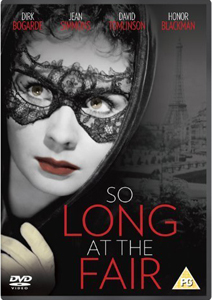“So Long at the Fair” (1950) takes a streamlined, but nonetheless enveloping, approach to a premise so good it’s almost a genre itself – one most famously tackled by Alfred Hitchcock in “The Lady Vanishes” (1938). It happens more in horror movies nowadays, and with many variations, but it amounts to this: A viewer is invited to wonder if a woman is crazy or if she’s the target of a vast gaslighting conspiracy.
Strictly speaking, “So Long at the Fair” – directed by Antony Darnborough and Terence Fisher – isn’t a remake of “The Lady Vanishes.” But it shares historical source material: the 19th century urban legend combo of The Vanishing Hotel Room and The Vanishing Lady.
Both Ethel Lina White, in her novel “The Wheel Spins” (1938), and Anthony Thorne, in his novel “So Long at the Fair” (1947), draw from these legends. Whereas White’s novel was mined only for the premise by Hitchcock, Thorne stays on board as the co-screenwriter of “So Long at the Fair.”

“So Long at the Fair” (1950)
Directors: Antony Darnborough, Terence Fisher
Writers: Anthony Thorne (screenplay, novel), Hugh Mills (screenplay)
Stars: Jean Simmons, Dirk Bogarde, David Tomlinson
More of a movie star vehicle
Anyone who has seen both movies will notice similarities, particularly in the frustrating yet compelling situation wherein it seems no one will help the main character in what should be a straightforward missing-person case. I recommend both, but – I know this is sacrilege, especially if you’re following this series as a Hitchcock fan – I find “So Long at the Fair” a tad better.
Eschewing both the comedy and the war games of Hitchcock’s film, “So Long” is a 19th century costume drama that carefully peppers in various angles on this broad mystery of “Where did Johnny Barton (David Tomlinson) disappear to and how and why?”
The film is more delightful than “Lady Vanishes” mostly because of super-cute Jean Simmons as Victoria Barton, a young Englishwoman having the time of her life on vacation in Paris. At first I thought she was with her wet towel of a husband, but Johnny turns out to be her brother – a mistake also initially made by fellow hotel guest George (Dirk Bogarde, like Simmons an attractive rising star of the time).
Maybe it’s a miscommunication by the filmmakers, but innocent confusion isn’t a bad way to start this movie. Despite its lighter mood, “So Long’s” directors have a Hitchcockian touch in that several characters and situations can have two possible meanings. For example, when one of the hoteliers stalks Vicky through Paris to the fair that has the city buzzing, he’s most likely sinister, but it’s possible he’s looking out for her.
And in other cases, they don’t. For instance, it’s obvious that George is a true ally of Vicky. And we’re happy for her, because she’s a desperate stranger in a strange land, sort of like Donald Sutherland’s Venice-stranded character in “Don’t Look Now” (1973). She doesn’t speak French, and Johnny is her guardian, as their parents are deceased. Vicky is strong-willed and likeable, but doesn’t have the established fortitude of “Lady’s” Margaret Lockwood.

Those dastardly French
Vicky’s and George’s possible romance is charmingly understated in that Old Hollywood way. Here we have a flip of the Hitchcock formula of the man on the run who must convince a strange woman he’s a good fellow.
Vicky is not exactly on the run, but she’d like to put the gaslighting hotel staff on the run from justice, and we sense the clock ticking: She’s low on money and can’t stay in Paris indefinitely. Seeing her need, George almost immediately helps her – which, honestly, most male viewers would do. Especially when we see the snarky ways the snooty hoteliers (this film does not dodge the French stereotype) cover up evidence, we want Vicky and George to win.
The Vanishing Lady/Hotel Room structure always has one more card to play at the end: What’s the reason for the bad guys to make the person disappear? “So Long” doesn’t play its very best card – although it plays fair in the sense that the revelation does have clues that I noticed but dismissed as trivial.
On the other hand, it’s a somewhat innocuous explanation, and one I had little chance of guessing because I had stupidly not grasped that I was watching a period piece – despite the horse-drawn carriages. Not all olden-days settings are the same, I should realize. Those who realize when the film is set might find the explanation quite clever.
Even those who find “The Lady Vanishes” to be richer shouldn’t find “So Long at the Fair” to be painful. No one will complain that 86 minutes is so long, especially when spending it with two movie stars and a good mystery.
RFMC’s Alfred Hitchcock series reviews works by the Master of Suspense, plus remakes and source material. Click here to visit our Hitchcock Zone.

